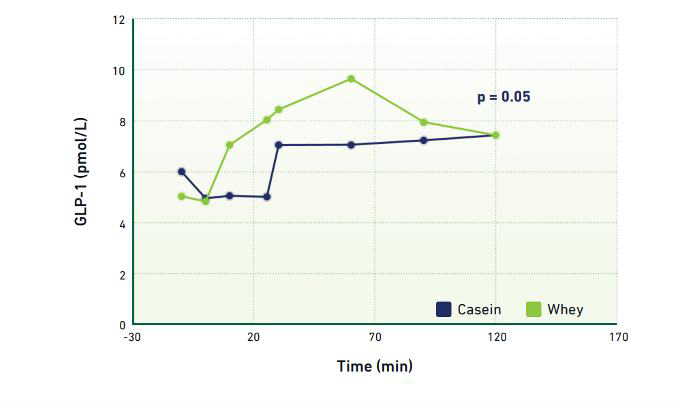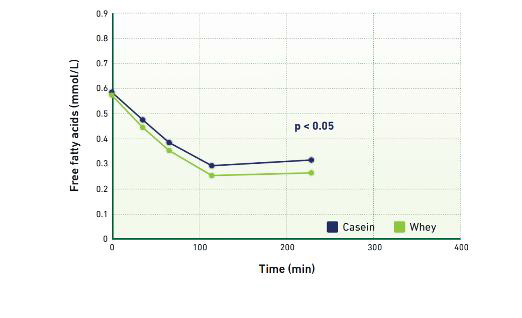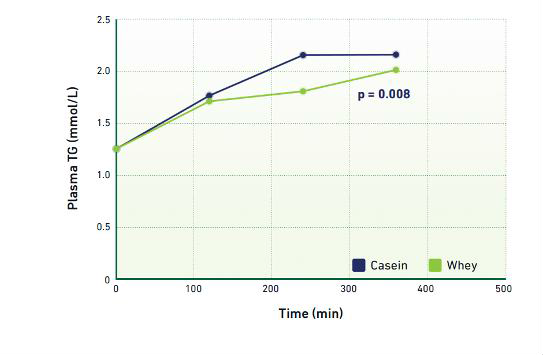Whey Protein as a Nutritional Supplement in Diabetes
Optimal diabetes care is critical in reducing the risk of complications. Besides drug therapies, nutritional therapy has come into focus in glycemic control. Among these, whey protein is a nutritional supplement that is of great benefit in managing postprandial hyperglycemia (PPH).1 This article explains the role of whey protein in glycemic control, discussing its mechanism of action and clinical evidence.
Whey Protein Mechanism of Action
Whey protein, as illustrated in figure 1, suppresses post-meal spikes in blood glucose through multiple mechanisms. Whey contains bioactive peptides and branched chain amino acids (BCAAs), which directly enhance glucose regulation through different mechanisms in the stomach, small intestine, pancreas, and brain.2-4 As a result, whey induces the release of incretin peptides and insulin while delaying gastric emptying.
As illustrated in figure 1, whey protein achieves its glycemic action through a variety of well-established mechanisms:
- Incretin Hormones: Consuming whey protein triggers the release of incretin hormones (GLP-1 and GIP) which in turn increase insulin and stop glucagon.2,3
- Insulin Secretion: Whey protein is rich in BCAAs. These amino acids directly stimulate beta cells to secrete insulin.
- Satiety: Whey protein delays the rate at which food leaves the stomach, thus minimizing sharp glucose spikes post-meal. Whey protein stimulates a sense of fullness by suppressing appetite-regulating hormones like ghrelin.1

Evidence-Based Whey Protein Benefits
Whey protein isn’t just popular for growing muscle or maintaining lean mass—research clearly shows it can help manage blood sugar levels. Multiple randomized controlled trials (RCTs) have demonstrated whey protein's efficacy in glycemic regulation in different types of patients, including type 2 diabetes (T2D), prediabetes, and metabolic syndrome patients. A meta-analysis of RCTs showed significant postprandial reduction in blood glucose after whey protein intake. One study resulted in a reduction of post-meal levels of glucose by over 30% when 25 grams of whey protein was taken as a preload 30 minutes before a meal consisting of carbohydrates. Additionally, different RCTs have shown an increase in insulin following intake of whey protein. Specifically, in one study a tripling of plasma levels of insulin was observed when whey was taken as a preload before a meal rich in carbohydrates.1
Whey Protein vs Casein Protein
Whey Protein Significantly Outperforms Casein Protein in Patients with T2D
GLP-1 levels were significantly higher following whey ingestion in T2D patients, whey protein induces a greater increase in GLP-1 than casein5

Blood glucose was significantly lower following whey ingestion in T2D patients, whey protein induces a greater reduction in PPH than casein6

Insulin level was significantly higher following whey ingestion in T2D patients, whey protein induces a 40% greater increase in Insulin than casein5

Free fatty acids levels were significantly lower following whey ingestion in T2D patients, whey protein induces a greater reduction in Free Fatty Acids than casein6

Blood triglyceride levels were significantly lower following whey ingestion in T2D patients, whey protein induces a greater reduction in postprandial Triglycerides than casein6

Whey protein has a greater increase in Total Amino Acids, BCAAs, and EAAs with potent insulinotropic properties than casein1,5

Whey Protein in Clinical Use
Whey protein supplementation for optimization of PPH is a question of careful planning, dosage, and formulation. The maximum postprandial glucose-reducing action occurs when whey protein is consumed as a preload, 30 minutes before a meal.1 Whey Protein Microgel (WPM), however, yields beneficial metabolic improvements when consumed a little earlier, about 15 minutes before a meal, due to its enhanced bioavailability, a lower dose of 10 grams of WPM can lower levels of PPH by 22% and enhance levels of insulin by 30–61%.7 Whereas standard whey protein requires 20–30 grams for it to induce release of insulin and enhance glycemic regulation.1 The formulation is another decisive factor. Whey protein is in concentrate, isolate, and hydrolysate forms, of which isolates and hydrolysates may be especially indicated for individuals who suffer from lactose intolerance.1
Renal and Diabetes Diet
Protein and Chronic Kidney Disease in the 2025 ADA Guidelines:
- In patients who have T2D and chronic kidney disease (CKD), however, protein intake must be adjusted based on CKD stage.
- For non-dialysis-dependent CKD of grade G3 and above, limit daily intake of proteins to 0.8 g/kg body weight, which is comparable to that for the normal population.
Diabetes Dialysis Diet
For dialysis patients, protein requirements increase to 1.0–1.2 g/kg/day to prevent protein energy wasting (PEW).8
Final Thoughts
Whey protein is an evidence-based, cost-effective solution for managing PPH which is a major risk for atherosclerosis. With its mechanism of releasing incretin hormone and insulin, whey protein addresses the root cause of PPH in patients with prediabetes, T2D, and metabolic syndrome. This makes whey protein an evidence-based nutritional supplement which can help control PPH and thus reduce cardiovascular risk.1
References:
- Mignone LE, et al. World J Diabetes. 2015;6:1274–84.
- Frid A, et al. Am J Clin Nutr. 2005;82:69–75.
- Smith K, et al. Front Nutr. 2020;7:587843.
- Gheldof N, et al. Nutrients. 2022;14:2674.
- Tessari P, et al. Diabetes Metab Res Rev. 2007;23:378–85.
- Mortensen LS, et al. Am J Clin Nutr. 2009;90:41–8.
- Neeland IJ, et al. Metabolites. 2025;15:61.
- American Diabetes Association. Diabetes Care. 2025;48(Suppl 1):S239–51.
Whey protein (WP) is a nutritional and non-pharmacological diabetes therapy. In fact, WP has emerged as a powerful supplement for diabetes, particularly in controlling postprandial hyperglycemia (PPH). Backed by evidence from clinical trials, whey protein has unique mechanism of action that can reduce PPH levels, improve glycemic control in type 2 diabetes patients.
